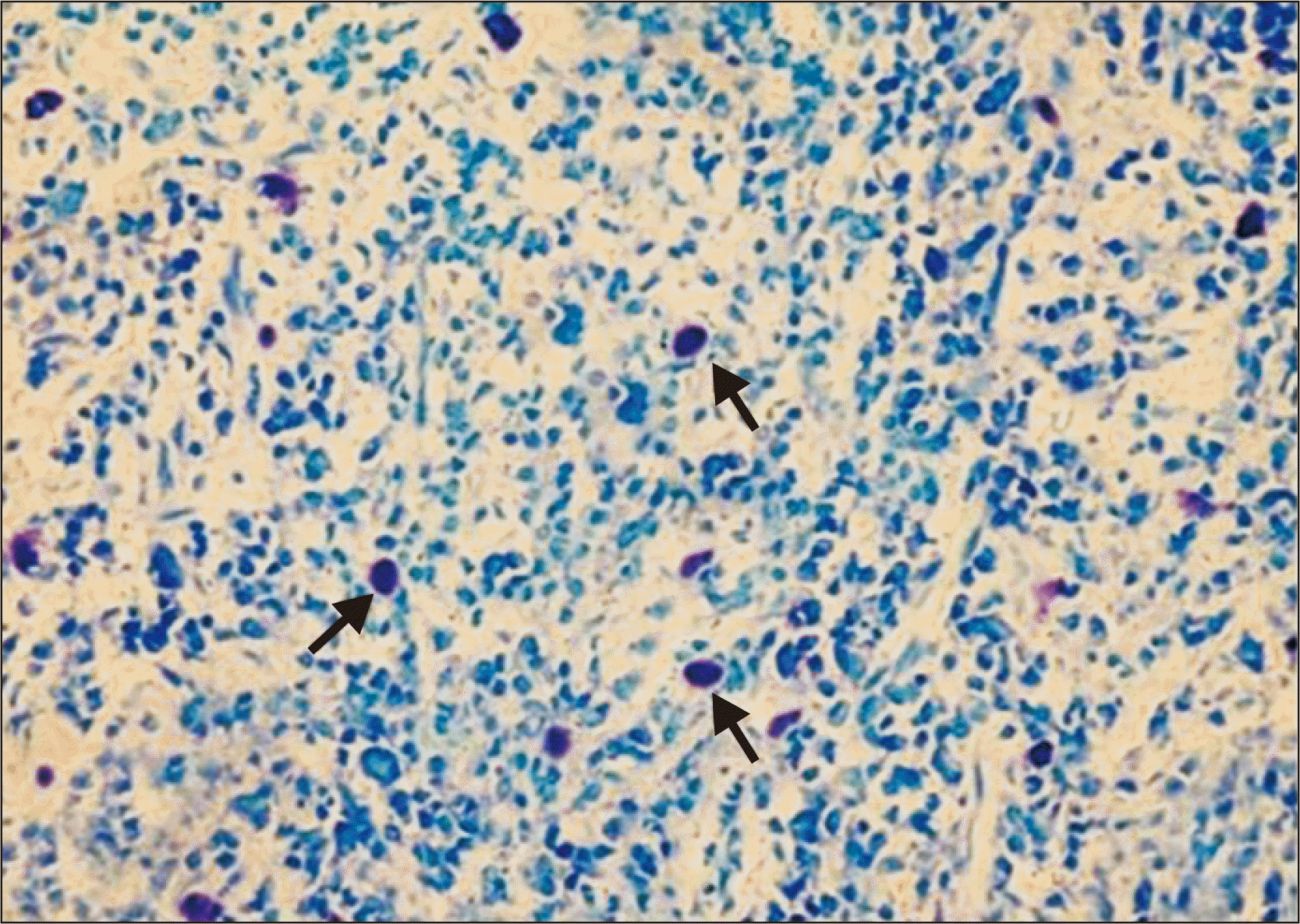3. Elpek GO, Gelen T, Aksoy NH, Erdoğan A, Dertsiz L, Demircan A, Keleş N. 2001; The prognostic relevance of angiogenesis and mast cells in squamous cell carcinoma of the oesophagus. J Clin Pathol. 54:940–4. DOI:
10.1136/jcp.54.12.940. PMID:
11729214. PMCID:
PMC1731336.

8. Sawai N, Koike K, Mwamtemi HH, Kinoshita T, Kurokawa Y, Sakashita K, Higuchi T, Takeuchi K, Shiohara M, Kamijo T, Ito S, Kato T, Miyazaki H, Yamashita T, Komiyama A. 1999; Thrombopoietin augments stem cell factor-dependent growth of human mast cells from bone marrow multipotential hematopoietic progenitors. Blood. 93:3703–12. DOI:
10.1182/blood.V93.11.3703. PMID:
10339477.

9. Okayama Y, Kawakami T. 2006; Development, migration, and survival of mast cells. Immunol Res. 34:97–115. DOI:
10.1385/IR:34:2:97.

10. Joseph S, Das S, Chand R, Roopa R, Thomas IM. 2003; Comparison of toluidine blue Vs thionin for mast cells in rat mesentery using Carnoy's fixative. J Anat Soc India. 52:166–7.
11. Moon TC, Befus AD, Kulka M. 2014; Mast cell mediators: their differential release and the secretory pathways involved. Front Immunol. 5:569. DOI:
10.3389/fimmu.2014.00569. PMID:
25452755. PMCID:
PMC4231949.

12. Wernersson S, Pejler G. 2014; Mast cell secretory granules: armed for battle. Nat Rev Immunol. 14:478–94. DOI:
10.1038/nri3690. PMID:
24903914.

13. Yamasaki S, Ishikawa E, Kohno M, Saito T. 2004; The quantity and duration of FcRγ signals determine mast cell degranulation and survival. Blood. 103:3093–101. DOI:
10.1182/blood-2003-08-2944. PMID:
15070690.

14. Krishnaswamy G, Kelley J, Johnson D, Youngberg G, Stone W, Huang SK, Bieber J, Chi DS. 2001; The human mast cell: functions in physiology and disease. Front Biosci. 6:D1109–27. DOI:
10.2741/krishnas. PMID:
11532608.

16. Pejler G, Knight SD, Henningsson F, Wernersson S. 2009; Novel insights into the biological function of mast cell carboxypeptidase A. Trends Immunol. 30:401–8. DOI:
10.1016/j.it.2009.04.008. PMID:
19643669. PMCID:
PMC6255860.

18. Huang B, Lei Z, Zhang GM, Li D, Song C, Li B, Liu Y, Yuan Y, Unkeless J, Xiong H, Feng ZH. 2008; SCF-mediated mast cell infiltration and activation exacerbate the inflammation and immunosuppression in tumor microenvironment. Blood. 112:1269–79. DOI:
10.1182/blood-2008-03-147033. PMID:
18524989. PMCID:
PMC2515142.

21. Dimitriadou V, Koutsilieris M. 1997; Mast cell-tumor cell interactions: for or against tumour growth and metastasis? Anticancer Res. 17:1541–9.
23. Norrby K. 1997; Mast cells and de novo angiogenesis: angiogenic capability of individual mast-cell mediators such as histamine, TNF, IL-8 and bFGF. Inflamm Res. 46(Suppl 1):7–8. DOI:
10.1007/PL00022372. PMID:
27517977.
24. Coussens LM, Raymond WW, Bergers G, Webster LM, Behrendtsen O, Werb Z, Caughey GH, Hanahan D. 1999; Inflammatory mast cells up-regulate angiogenesis during squamous epithelial carcinogenesis. Genes Dev. 13:1382–97. DOI:
10.1101/gad.13.11.1382. PMID:
10364156. PMCID:
PMC316772.

25. Tomita M, Matsuzaki Y, Edagawa M, Shimizu T, Hara M, Sekiya R, Onitsuka T. 2001; Association of mast cells with tumor angiogenesis in esophageal squamous cell carcinoma. Dis Esophagus. 14:135–8. DOI:
10.1046/j.1442-2050.2001.00171.x. PMID:
11553224.

26. Kwon GY, Lee SD, Park ES. 2005; Mast cell and macrophage counts and microvessel density in invasive breast carcinoma-comparison analysis with clinicopathological parameters. Cancer Res Treat. 37:103–8. DOI:
10.4143/crt.2005.37.2.103. PMID:
19956488. PMCID:
PMC2785399.

28. Iamaroon A, Pongsiriwet S, Jittidecharaks S, Pattanaporn K, Prapayasatok S, Wanachantararak S. 2003; Increase of mast cells and tumor angiogenesis in oral squamous cell carcinoma. J Oral Pathol Med. 32:195–9. DOI:
10.1034/j.1600-0714.2003.00128.x. PMID:
12653857. PMCID:
PMC5051296.

32. Amini RM, Aaltonen K, Nevanlinna H, Carvalho R, Salonen L, Heikkilä P, Blomqvist C. 2007; Mast cells and eosinophils in invasive breast carcinoma. BMC Cancer. 7:165. DOI:
10.1186/1471-2407-7-165. PMID:
17727696. PMCID:
PMC2048965.

34. Ribatti D, Ennas MG, Vacca A, Ferreli F, Nico B, Orru S, Sirigu P. 2003; Tumor vascularity and tryptase-positive mast cells correlate with a poor prognosis in melanoma. Eur J Clin Invest. 33:420–5. DOI:
10.1046/j.1365-2362.2003.01152.x. PMID:
12760367.

35. Peng SH, Deng H, Yang JF, Xie PP, Li C, Li H, Feng DY. 2005; Significance and relationship between infiltrating inflammatory cell and tumor angiogenesis in hepatocellular carcinoma tissues. World J Gastroenterol. 11:6521–4. DOI:
10.3748/wjg.v11.i41.6521. PMID:
16425427. PMCID:
PMC4355797.

36. Yodavudh S, Tangjitgamol S, Puangsa-art S. 2008; Prognostic significance of microvessel density and mast cell density for the survival of Thai patients with primary colorectal cancer. J Med Assoc Thai. 91:723–32. PMID:
18672639.
37. Tan SY, Fan Y, Luo HS, Shen ZX, Guo Y, Zhao LJ. 2005; Prognostic significance of cell infiltrations of immunosurveillance in colorectal cancer. World J Gastroenterol. 11:1210–4. DOI:
10.3748/wjg.v11.i8.1210. PMID:
15754407. PMCID:
PMC4250716.

38. Kandhare AD, Aswar UM, Mohan V, Thakurdesai PA. 2017; Ameliorative effects of type-A procyanidins polyphenols from cinnamon bark in compound 48/80-induced mast cell degranulation. Anat Cell Biol. 50:275–83. DOI:
10.5115/acb.2017.50.4.275. PMID:
29354299. PMCID:
PMC5768564.

39. Khatami M. 2005; Cyclooxygenase inhibitor ketorolac or mast cell stabilizers: immunologic challenges in cancer therapy. Clin Cancer Res. 11:1349–51.




 PDF
PDF Citation
Citation Print
Print




 XML Download
XML Download